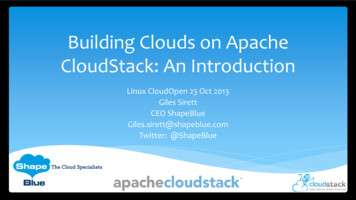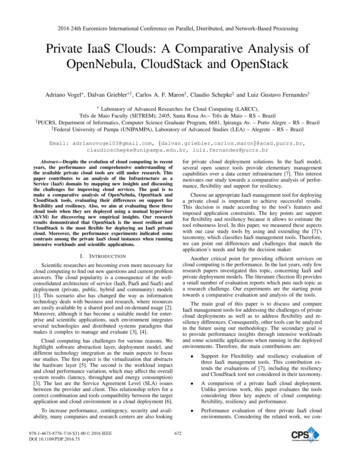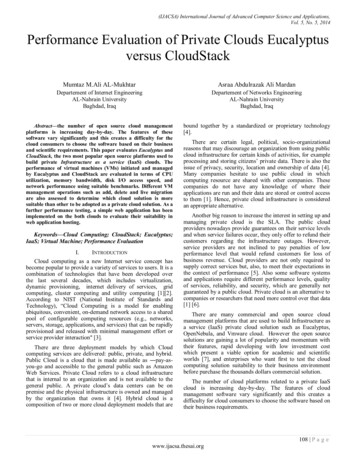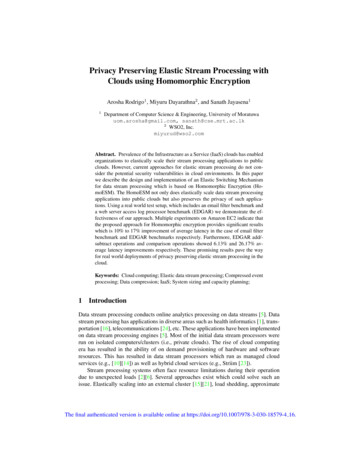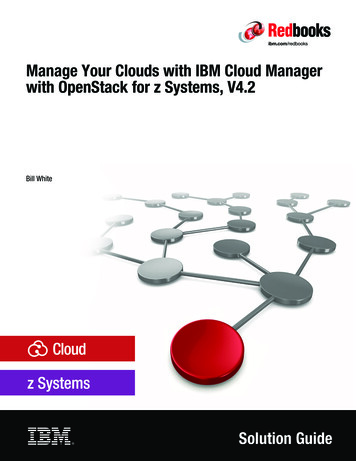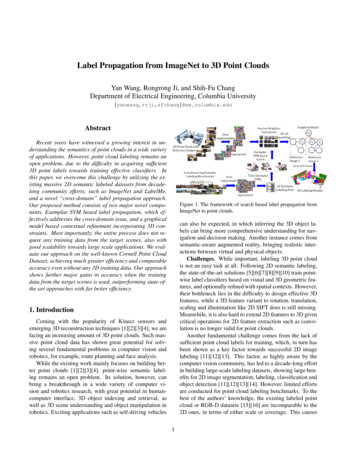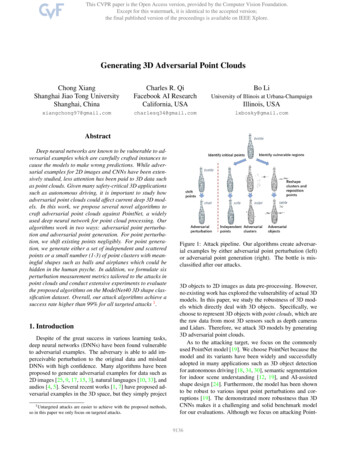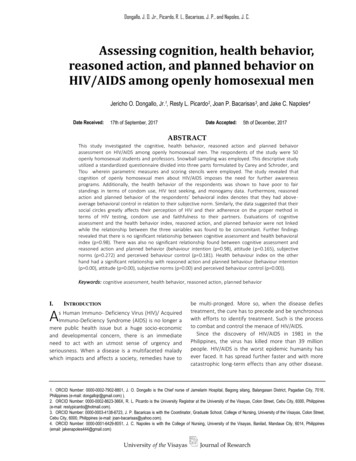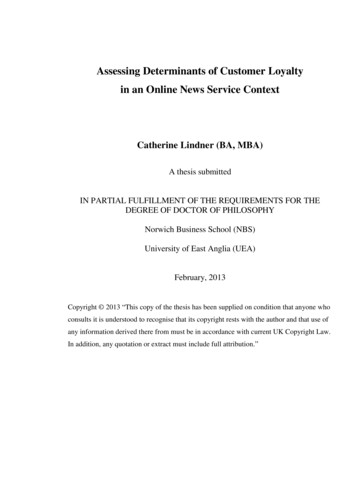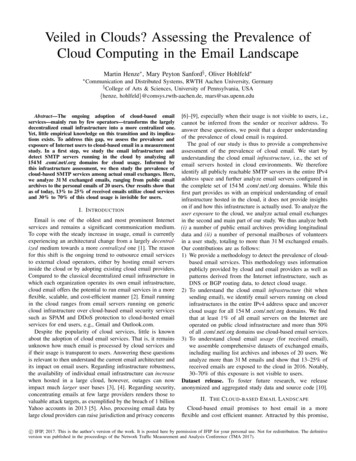
Transcription
Veiled in Clouds? Assessing the Prevalence ofCloud Computing in the Email LandscapeMartin Henze , Mary Peyton Sanford§ , Oliver Hohlfeld Communicationand Distributed Systems, RWTH Aachen University, Germanyof Arts & Sciences, University of Pennsylvania, USA{henze, hohlfeld}@comsys.rwth-aachen.de, mars@sas.upenn.edu§ College[6]–[9], especially when their usage is not visible to users, i.e.,cannot be inferred from the sender or receiver address. Toanswer these questions, we posit that a deeper understandingof the prevalence of cloud email is required.The goal of our study is thus to provide a comprehensiveassessment of the prevalence of cloud email. We start byunderstanding the cloud email infrastructure, i.e., the set ofemail servers hosted in cloud environments. We thereforeidentify all publicly reachable SMTP servers in the entire IPv4address space and further analyze email servers configured inthe complete set of 154 M .com/.net/.org domains. While thisfirst part provides us with an empirical understanding of emailinfrastructure hosted in the cloud, it does not provide insightson if and how this infrastructure is actually used. To analyze theI. I NTRODUCTIONuser exposure to the cloud, we analyze actual email exchangesEmail is one of the oldest and most prominent Internet in the second and main part of our study. We thus analyze bothservices and remains a significant communication medium. (i) a number of public email archives providing longitudinalTo cope with the steady increase in usage, email is currently data and (ii) a number of personal mailboxes of volunteersexperiencing an architectural change from a largely decentral- in a user study, totaling to more than 31 M exchanged emails.ized medium towards a more centralized one [1]. The reason Our contributions are as follows:for this shift is the ongoing trend to outsource email services 1) We provide a methodology to detect the prevalence of cloudto external cloud operators, either by hosting email serversbased email services. This methodology uses informationinside the cloud or by adopting existing cloud email providers.publicly provided by cloud and email providers as well asCompared to the classical decentralized email infrastructure inpatterns derived from the Internet infrastructure, such aswhich each organization operates its own email infrastructure,DNS or BGP routing data, to detect cloud usage.cloud email offers the potential to run email services in a more 2) To understand the cloud email infrastructure (hit whenflexible, scalable, and cost-efficient manner [2]. Email runningsending email), we identify email servers running on cloudin the cloud ranges from email servers running on genericinfrastructures in the entire IPv4 address space and uncovercloud infrastructure over cloud-based email security servicescloud usage for all 154 M .com/.net/.org domains. We findsuch as SPAM and DDoS protection to cloud-hosted emailthat at least 1% of all email servers on the Internet areservices for end users, e.g., Gmail and Outlook.com.operated on public cloud infrastructure and more than 50%Despite the popularity of cloud services, little is knownof all .com/.net/.org domains use cloud-based email services.about the adoption of cloud email services. That is, it remains 3) To understand cloud email usage (for received email),unknown how much email is processed by cloud services andwe assemble comprehensive datasets of exchanged emails,if their usage is transparent to users. Answering these questionsincluding mailing list archives and inboxes of 20 users. Weis relevant to then understand the current email architecture andanalyze more than 31 M emails and show that 13–25% ofits impact on email users. Regarding infrastructure robustness,received emails are exposed to the cloud in 2016. Notably,the availability of individual email infrastructure can increase30–70% of this exposure is not visible to users.when hosted in a large cloud, however, outages can now Dataset release. To foster future research, we releaseimpact much larger user bases [3], [4]. Regarding security, anonymized and aggregated study data and source code [10].concentrating emails at few large providers renders those toII. T HE C LOUD - BASED E MAIL L ANDSCAPEvaluable attack targets, as exemplified by the breach of 1 billionYahoo accounts in 2013 [5]. Also, processing email data byCloud-based email promises to host email in a morelarge cloud providers can raise jurisdiction and privacy concerns flexible and cost efficient manner. Attracted by this promise,Abstract—The ongoing adoption of cloud-based emailservices—mainly run by few operators—transforms the largelydecentralized email infrastructure into a more centralized one.Yet, little empirical knowledge on this transition and its implications exists. To address this gap, we assess the prevalence andexposure of Internet users to cloud-based email in a measurementstudy. In a first step, we study the email infrastructure anddetect SMTP servers running in the cloud by analyzing all154 M .com/.net/.org domains for cloud usage. Informed bythis infrastructure assessment, we then study the prevalence ofcloud-based SMTP services among actual email exchanges. Here,we analyze 31 M exchanged emails, ranging from public emailarchives to the personal emails of 20 users. Our results show thatas of today, 13% to 25% of received emails utilize cloud servicesand 30% to 70% of this cloud usage is invisible for users.c IFIP, 2017. This is the author’s version of the work. It is posted here by permission of IFIP for your personal use. Not for redistribution. The definitiveversion was published in the proceedings of the Network Traffic Measurement and Analysis Conference (TMA 2017).
Cloud ServicePHISMSource(s)large corporations have been shifting their on-premise email1&1###[11]infrastructure to the cloud. To understand this trend, we start byAdobe[12]Amazon##[13]dissecting the different types of email services that are realizedAOL[14]in the cloud today. Here, we define cloud email infrastructuresAppRiver#[15]as large-scale hosting infrastructures run by third-parties andCenturyLink###[13]Cisco##[15]providing services to a large number of users.Comcast#[14]Before the emergence of cloud-based email services, outEpsilon[12]sourced email services could be generally differentiated intoExperian[12]Fujitsu##[13]email providers and email hosters. When moving to the cloud,GoDaddy##[11]the landscape of email services becomes more diverse:Google[11], [13], [14]Email providers. Email providers offer typical email services,IBM (SoftLayer)#[13]iCloud[14]i.e., a mailbox with the possibility to send and receive emails.MAX MailProtection[15]Notably, email addresses served by email providers are boundMcAfee[15]Microsoft###[13], [14]to the domain of the individual provider (e.g., @aol.com).Mimecast#[15]Email providers normally offer services for free and financeNTT Communications#[13]their services through advertisements.Oracle#[12]OVH#[11]Email hosters. Email hosters offer basic email services underProofpoint[15]the domain of the customer, where each customer will haveRackspace#[13]their own domain (e.g., @example.com). Typically, emailSalesforce[12]Strato#[11]hosters charge for their services, e.g., based on the size andSymantec[15]amount of mailboxes. While private users also use hosters,TrendMicro[15]the majority of customers are corporations and businesses. InVirtustream[13]VMware[13]contrast to email providers, it is not possible to derive theYahoo#[14]hoster directly from a hosted email address.Email on cloud infrastructure. Cloud computing enables Table 1. Our selection of 31 major cloud email vendors. We denote thecloud-based email service(s) for which we selected a vendor by , while #the transformation of arbitrary services from own on-premise- denotes other services offered by this vendor (where it is not a major vendor).hardware to virtualized infrastructure running in a clouddata center. This allows the transfer of previously self-hostedemail servers to cloud infrastructure. The main motivations potential questions on infrastructure resilience and cloud-relatedare cost reductions, lower maintenance efforts, and higher privacy exposures of email. Following the classification derivedscalability and elasticity. As moving an email server to a cloud in this section, we next describe a methodology which we useinfrastructure still requires the setup and administration of an to assess this prevalence in empirical data.email server, this approach is mainly pursued by businesses.Email security. Mail servers are subject to a number of securityIII. M ETHODOLOGYthreats, ranging from SPAM and malware to DDoS attacks,We start by deriving a methodology that enables us to detectfrom which cloud-based email security services promise betterthe usage of cloud-based email services based on IP and/orprotection. This is achieved by relaying email via securityDNS information. It utilizes information publicly provided byproxies for both incoming and outgoing emails.cloud and email providers as well as patterns derived from theEmail marketing. Cloud-based email marketing servicesInternet infrastructure such as DNS or BGP routing data.enable the sending of massive amounts of highly personalizedemails for marketing purposes, e.g., to advertise products,A. Representative Set of Cloud Servicesengage with customers, or solicit donations.Notably, these categories are neither unambiguous nor disTo evaluate the prevalence of cloud-based email services, wetinct. For example, larger email providers often additionally of- first derive a representative set of cloud services which we wantfer customers to host customer domains, e.g., example.com to classify. To this end, we select the most prominent cloud(while less known, e.g., Google and Microsoft also offer email services for each of the different types of cloud-based emailhosting). Furthermore, a provider can offer more than one services previously identified in Section II for our analysis.service, e.g., generic cloud infrastructure and email marketing We depict the resulting selected cloud services in Table 1 within the case of Amazon. Hence, only an exhaustive picture filled circles and, in the following, focus on justifying theof the landscape of cloud-based email services ensures a full reasoning behind our selection. Note that one company canunderstanding of the impact of cloud computing on email users. offer different types of cloud-based services (e.g., Amazon). InThe goal of this paper is to provide an empirical assessment these cases, we merge the different services, which is indicatedon the prevalence of cloud computing in the current email by multiple circles in the table. Additionally, we depict otherinfrastructure. Shedding light on this question is relevant services of cloud vendors that we do not classify as one of the(i) to understand the ongoing change from decentralized to most prominent services in their category (e.g., Yahoo’s emailcentralized email infrastructures and (ii) to better understand hosting service) with empty circles in Table 1.
Email providers (P). We base our selection of cloud-basedemail providers on a survey conducted by Adestra [14]. Inour analysis, we include the six most popular email providerswhich are used by the 1 200 study participants (US residents,all age ranges) as primary email provider. These six providersaccount for 96% of the participant’s primary email providers.Email hosters (H). For cloud email hosters, we are especiallyinterested in services hosting emails for a large number ofdomains. We rely on measurements performed by DomainToolson the most popular mail servers based on the number ofdomains they serve [11]. Based on these results, we includethe top five hosters of popular mail servers in our analysis.Cloud infrastructure (I). Our selection of cloud infrastructure(IaaS) providers builds upon a market analysis performed byGartner [13]. Based on this analysis, we selected the ten cloudinfrastructure services with the highest market share, as thosejointly dominate the market [13].Email security (S). For our selection of cloud-based emailsecurity services, we rely on the analysis tools of CloudEmailSecurity.org [15]. We include all eight services that arefeatured in this survey into our analysis.Email marketing (M). We base our selection of cloud-basedemail marketing services on an analysis performed by Forrester[12]. From these results, we derive the five services with thestrongest market presence for our analysis.Fig. 1. Cloud usage among publiclyreachable SMTP servers (in permil).Fig. 2.Cloud usage among.com/.net/.org domains (in percent).require a different approach to obtain information on usedhostnames. To this end, we augment the information we wereable to retrieve directly from services with information fromSenderBase [19]. This enabled us to retrieve the hostnamesused by all 31 cloud services under study. In the context ofour study, we consider hostnames to be more reliable than IPaddresses, as they are more stable over time.IV. P REVALENCE OF C LOUD E MAIL I NFRASTRUCTURESWe begin by assessing the prevalence of cloud services inthe global email infrastructure, i.e., the share of email servershosted in the cloud, hit when sending email. To answer thisquestion, we perform two large-scale active measurements.B. Detection Patterns for Cloud ServicesEmail servers running on cloud infrastructure. Our firstTo quantify the prevalence of cloud services among email measurement aims at assessing all publicly reachable mailusers, we require patterns enabling this detection. Most notably, servers. This study utilizes a trace of a port scan on SMTPthis includes IP addresses and DNS names. We next illustrate port 25/tcp performed on November 19, 2016 covering theentire IPv4 address space and subsequently grabbing SMTPhow these patterns can be derived from public information.IP addresses. Most, especially larger, cloud infrastructure banners [20]. Out of 16.3 M reachable IPs, 6.4 M are classifiedservices publish the IP addresses they use, e.g., to allow as valid SMTP servers indicated by a valid 250 status codecustomers to configure their firewalls [16]. We could retrieve in the SMTP EHLO banner. We then apply our collection ofinformation on used IP addresses for six cloud infrastructures cloud infrastructure IP address ranges (column “I” in Table 1)directly from the service. Similarly, all eight cloud-based email to identify mail servers hosted by the ten most importantsecurity services make their IP addresses publicly available, cloud infrastructure providers. Our results in Figure 1 showas their customers must restrict their mail servers to only that 1.44% (93 k IPs) of the email servers on the Internet areaccept incoming emails from these IPs. All cloud-based email operated in the networks of these cloud infrastructure providers.providers we study publish the IP addresses they use to send Notably, 60.13% (56 k IPs) of these servers are operated onemails for two reasons: (i) to ease white listing in firewalls or infrastructure provided by Amazon. These results indicate that(ii) to protect against forging of sender names, e.g., using the cloud infrastructure is indeed utilized to provide email services.Sender Policy Framework [17]. For cloud-based email hosters, However, their footprint in terms of IP addresses is rather smallwe were able to directly retrieve IP addresses from two of and unlike to serve as proxy for usage/popularity.them. In contrast, we were not able to retrieve information Cloud usage by .com/.net/.org domains. While the firston used IP addresses directly from the service for all five measurement assesses the cloud usage of all publicly reachablecloud-based email marketing services, three email hosters, and mail servers, it does not identify whether the identified IPs arefour cloud infrastructures. Only in these cases, we looked-up in use. That is, while the previously identified IP addresses arethe autonomous system number(s) [18] used by these services publicly reachable mail servers, they do not necessarily haveand retrieved the associated IP address ranges from the BGP to be configured by any domain as Mail Exchange (MX) toinformation provided by ipinfo.io and radb.net. In the actually receive email. To answer this question, we performedend, we were able to retrieve information on the utilized IP a second measurement querying the MX DNS records of theaddresses for all 31 cloud services.complete set of 154 M .com/.net/.org domains (DNS zone filesDNS names. Similar to IP addresses, some cloud-based email provided by Verisign and the Public Interest Registry) on Novservices also publish the DNS hostnames they use. However, 20, 2016. We obtained MX records for 140 M domains, whilethis fraction of services is significantly smaller. Hence, we 1.2 M were invalid and 12.8 M suffered from authoritative name
server errors or timeouts. Out of the obtained 31.9 M distinct Received: from mail-qk0-f169.google.com ([209.85.220.169])by mx-2.rz.rwth-aachen.de with ESMTP/TLS/AES128-SHA;MX records, 30.6 M could be resolved to 2.8 M distinct IPs. We07 Nov 2016 14:37:56 0100remark that the number of detected IPs is lower as compared Received: by mail-qk0-f169.google.com with SMTP id n21so 64861883qka.3 for @comsys.rwth-aachen.de ;to the first measurement since (i) not the entire DNS spaceMon, 07 Nov 2016 05:37:56 -0800 (PST)was scanned and (ii) not every IP must be configured as MX. DKIM-Signature: v 1; a rsa-sha256; c relaxed/relaxed;d gmail.com; s 20120113; h mime-version:reply-to: The intuition behind this measurement is that any mail serverfrom:date:message-id:subject:to; bh 0i V1[.]YJrA ;configured as MX in the DNS is intended to receive email.b bb1p9[.]n0Bw In contrast to our first measurement, we now have additional X-Google-DKIM-Signature: v 1; a rsa-sha256; c relaxed/ relaxed; d 1e100.net; s 20130820; h x-gm-message- DNS information available allowing us to match IP d: subject:to; bh 0i V1[.]YJrA ; b hTvXs[.]aMA hostname against the complete set of 31 cloud-based emailX-Gm-Message-State: ABUng[.]DCw providers listed in Table 1. In Figure 2, we show the relative Received: by with HTTP; Mon, 7 Nov 2016 05:37:54 -0800 (PST)share of domains being served by mail servers of one of theseFrom: @gmail.com 31 cloud-based email services for all 154 M .com/.net/.org. Date: Mon, 7 Nov 2016 08:37:54 -0500Our results show that, in total, 52.27% of the probed domains Message-ID: CADLj[.]2b 9g@mail.gmail.com Subject: use a cloud-based email service. These numbers are largely To: @comsys.rwth-aachen.de dominated by GoDaddy, which accounts for 35.36% of the Listing 1. Information contained in email headers offers different opportunitiesdomains served by a small number of servers (34.81 M domains to detect exposure to cloud-based email services.resolving to only 1 732 distinct IP addresses for our vantagepoint). The dominance of GoDaddy is explained by the factthat it is the world’s largest domain registrar, also providing potential cloud usage based on sender and receiver informationemail services to registered domains; whether these are in (red), which can uncover hidden cloud usage.use is unknown. The other widely used services are the Received lines: The main purpose of received lines is to
scalability and elasticity. As moving an email server to a cloud infrastructure still requires the setup and administration of an email server, this approach is mainly pursued by businesses. Email security. Mail servers are subject to a number of securit
